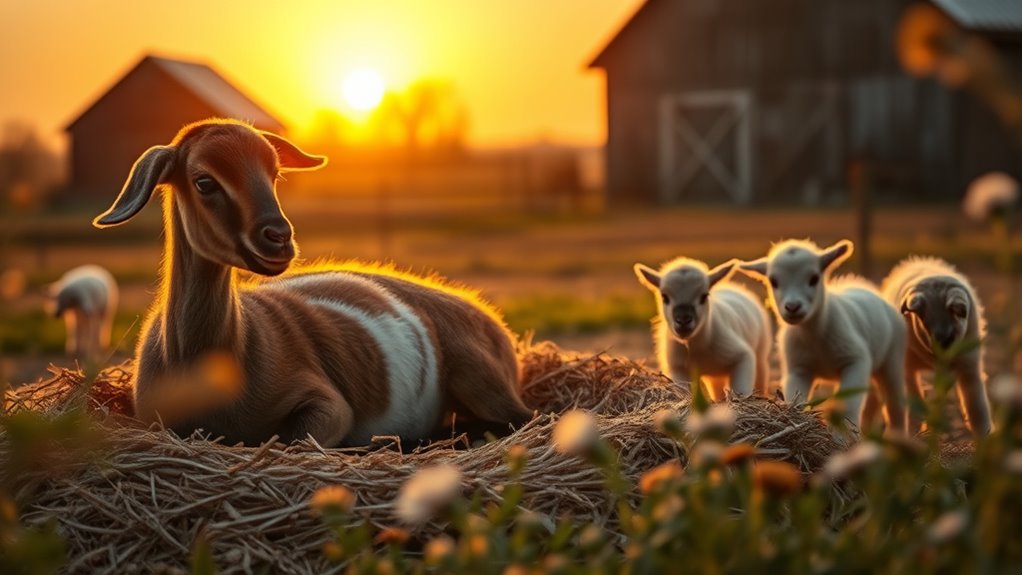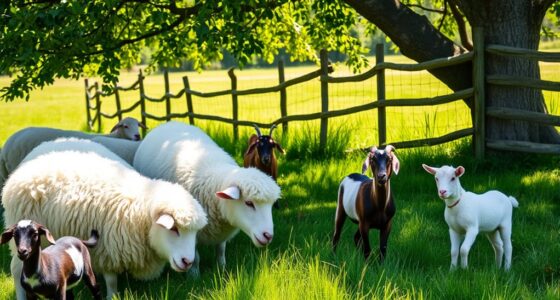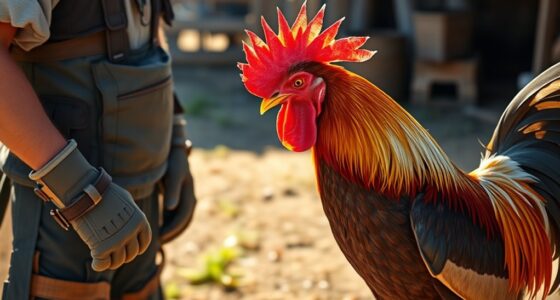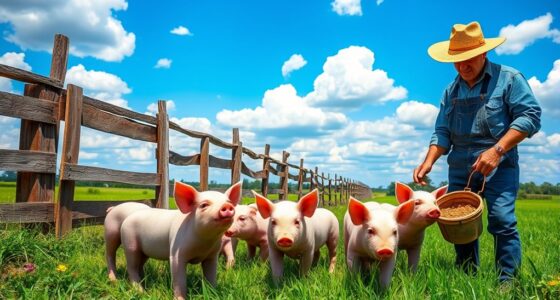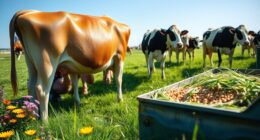Goat pregnancy involves three main stages: the first trimester focuses on early development, with rapid changes occurring in the first 50 days. In the second trimester, you'll notice significant fetal growth, and by day 78, major organs are visible. Finally, the third trimester prepares the doe for kidding, requiring increased nutrition and a safe, clean area. Keep an eye on her health throughout. There's much more to understand about each stage and what to expect.
Key Takeaways
- Goat gestation lasts 145 to 155 days, varying by breed size and health factors.
- The first trimester focuses on early development, requiring slight increases in protein and energy intake.
- During the second trimester, significant fetal growth occurs, with heart activity visible by day 28.
- In the third trimester, prepare a safe kidding area and increase nutrition to support the doe.
- Regular health monitoring and vaccinations are crucial throughout pregnancy to ensure the well-being of both doe and kids.
Understanding Goat Gestation Period

When you're raising goats, understanding the gestation period is essential for successful breeding. Typically, goat gestation lasts between 145 to 150 days for miniature breeds and 150 to 155 days for standard breeds.
Factors like breed size, nutrition, and the doe's estrus cycle can influence this duration. First-time mothers might've slightly longer pregnancies, while larger litters may shorten gestation.
Proper nutrition is crucial, especially in the third trimester, to prevent complications like pregnancy toxemia. Regular health checks help you catch potential issues early, and keeping detailed records can assist in managing future pregnancies.
Pre-Breeding Care for Does

Preparing your does for breeding is just as important as understanding their gestation period. First, evaluate their body condition; both overweight and underweight does can face complications.
Make sure to administer necessary vaccinations like CD&T to protect against diseases. Deworm your does to prevent parasite issues and trim their hooves for optimal mobility.
Administer essential vaccinations, deworm does, and trim hooves to ensure their health and mobility before breeding.
Next, enhance their diet with high-protein supplements and ensure they've free-choice minerals. Increasing energy intake one to two months before breeding helps improve ovulation rates.
Provide adequate shelter and train your does for easy handling. Monitor their health regularly, and choose healthy bucks to breed with. Additionally, keeping detailed records will help you track breeding success and ensure a smooth process while also being aware of pregnancy signs that may indicate when to prepare for delivery.
First Trimester: Early Development
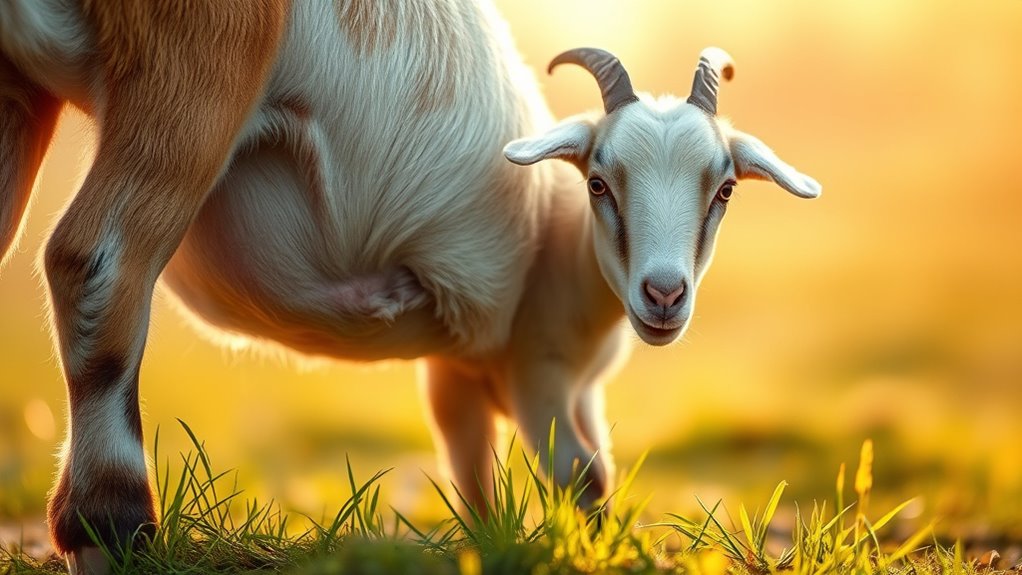
As your does enter the first trimester of pregnancy, understanding early development is crucial for their health and the successful growth of the embryos. This stage lasts from day 1 to 50 of gestation.
During the first few days, a single sperm fertilizes the egg, leading to rapid cell division. By day 1.5, your embryo reaches the morula stage with eight cells. Around day 12, the blastocyst attaches to the uterine wall.
To support this early development, you'll need to slightly increase their protein and energy intake while ensuring they've constant access to clean water.
Regular observation for health issues and reducing stress by keeping them with familiar goats can significantly impact their well-being during this critical period.
Second Trimester: Fetal Growth

During the second trimester, fetal growth accelerates significantly, marking a pivotal stage in your doe's pregnancy.
By around day 28, you can see the fetal heart activity on ultrasound, and by day 78, organs like the heart, kidney, and liver become visible. The umbilical cord first appears between days 32 and 35, while fetal movement, including mouth motions, becomes more pronounced.
By day 60, the fetus reaches about 4 inches in length, with skeletal structures becoming clearer. You'll notice developmental milestones like the opening of the ear canal and the visibility of nostrils around days 49 to 56.
This growth period is crucial, so keep monitoring your doe's health and nutrition for optimal fetal development.
Third Trimester: Late Pregnancy Preparation

In the final stages of goat pregnancy, ensuring your doe receives the right nutrition and care is critical for her health and the developing kids.
You'll need to increase her energy and protein intake, focusing on high-quality hay and alfalfa. Adequate calcium is essential to prevent milk fever, especially if you're feeding low-calcium grains.
Vaccinate your doe against clostridium and tetanus about three weeks before kidding, and keep a close eye on her health. Separating her from the flock can help manage her nutrition better.
Don't forget to prepare a clean, safe kidding area in advance, and monitor her for signs of labor, like udder changes and restlessness.
Regular hoof trimming will also ensure her comfort.
The Kidding Process: What to Expect
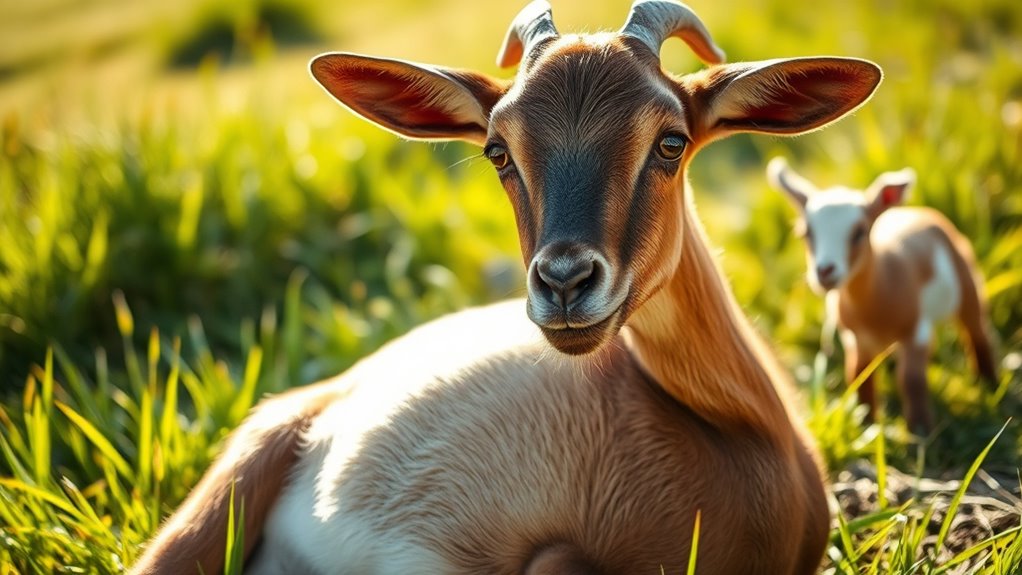
After preparing your doe for the final stages of pregnancy, it's time to focus on the kidding process itself.
Kidding, the act of giving birth, involves three key stages: preparation, delivery, and afterbirth. As labor approaches, watch for signs like softening tail ligaments, mucous discharge, and changes in the udder.
The first stage lasts up to 12 hours, with uterine contractions preparing for delivery. The second stage, usually under two hours, involves the doe pushing out the kids.
The first stage of kidding can last up to 12 hours, followed by a rapid delivery phase of under two hours.
After delivery, expect the afterbirth stage, which occurs within a few hours. Keep a close eye on her behavior and have a kidding kit ready.
If complications arise, don't hesitate to seek veterinary assistance to ensure a smooth process.
Postpartum Care for Newborn Kids
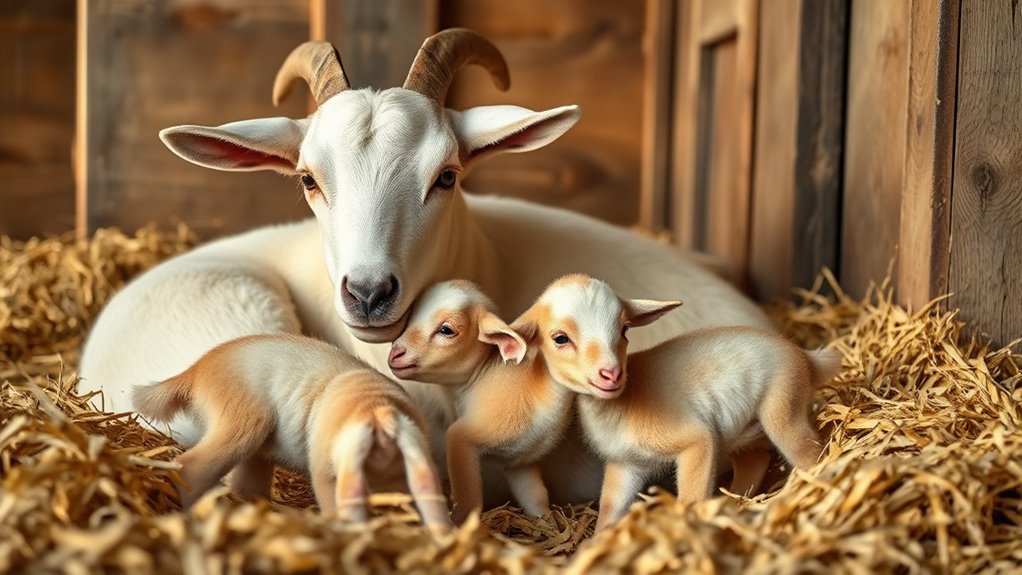
While the excitement of welcoming newborn kids is palpable, their care immediately after birth is crucial for ensuring their health and vitality.
Start by clearing their airways of mucus, as this helps them breathe properly. If they struggle, rub them with straw or a towel, or hold them upside down to drain excess fluid.
Dry them thoroughly to prevent chilling. Ensure they receive colostrum within hours to boost their immune systems; aim for about 10% of their body weight.
Trim the umbilical cord and treat it with iodine to prevent infection. Monitor their weight, temperature, and nursing success closely, and provide a calm environment for bonding.
This attentive care lays the foundation for their growth and well-being.
Frequently Asked Questions
Can Goats Have Multiple Pregnancies in a Year?
Yes, goats can have multiple pregnancies in a year. You can breed them again shortly after they give birth, but it's best to allow for a recovery period.
Typically, you can manage breeding cycles to have does pregnant about every six months. Factors like age, nutrition, and breed characteristics play a big role in their ability to conceive multiple times.
With proper management, you can optimize their reproductive potential effectively.
What Are Common Complications During Goat Pregnancy?
Did you know that about 26% of goats face retained fetal membranes during pregnancy?
Common complications during goat pregnancy include retained membranes, vaginal trauma, and uterine tears, which can be fatal if not treated quickly.
Factors like dystocia and nutritional deficiencies contribute to these issues.
You should watch for signs like refusal to eat or prolonged labor, as they can indicate serious problems requiring veterinary intervention and proper care.
How Can I Tell if My Doe Is in Labor?
To tell if your doe is in labor, watch for signs like restlessness and vocalizations.
You might notice her pacing or pawing at the ground. Look for physical changes too, such as a swollen vulva and softened tail ligaments.
As labor approaches, she may stop eating and seek a quiet space.
Keep an eye out for visible contractions and the appearance of a water bag, signaling that birth is imminent.
What Breeds Are Most Prone to Pregnancy Problems?
Imagine a tightrope walker balancing precariously; some goat breeds, like Boer and certain dairy breeds, face similar challenges during pregnancy.
They're more prone to issues like pregnancy toxemia and ketosis, especially if they're over or under-conditioned.
Maintaining a balanced diet and watching their weight can significantly improve their chances of a healthy pregnancy.
How Do Environmental Factors Affect Goat Pregnancy?
Environmental factors significantly impact your goats' pregnancy. Heat stress can lower fertility rates, so you need to monitor temperature and humidity levels.
Breed tolerance varies, with some goats adapting better to extreme conditions. Seasonal changes also influence birth weights and growth rates, making nutrition crucial during harsh weather.
Conclusion
In conclusion, understanding goat pregnancy helps you prepare for the incredible journey ahead. Did you know that a typical goat's gestation lasts about 150 days? That's roughly five months of anticipation, excitement, and preparation for the arrival of adorable kids. By following the outlined stages, from pre-breeding care to postpartum support, you'll ensure a healthy, happy experience for both your does and their newborns. Embrace this rewarding adventure, and enjoy every moment of it!

